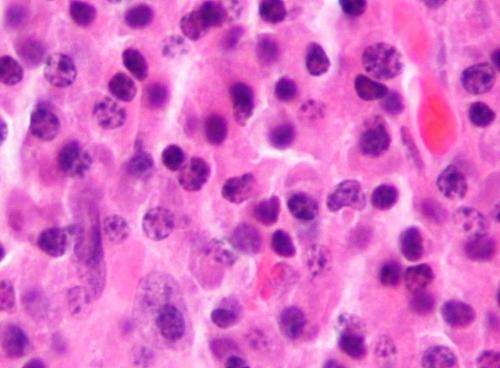Multiple myeloma hides in bones like a wolf in sheep's clothing

Multiple myeloma uses a trick akin to a wolf in sheep's clothing to grow in and spread to new bone sites. By overexpressing Runx2, a gene that normally is a master regulator of bone formation, the cells of this largely incurable cancer produce proteins that mimic the normal bone-resident cells, according to research published in the journal Blood by Yang Yang, M.D., Ph.D., associate professor of pathology at the University of Alabama at Birmingham.
This is the first study of the Runx2 expression in multiple myeloma, a cancer of the white blood cells that causes an estimated 11,000 deaths a year in the U.S., says Yang, who is also a scientist in UAB's Comprehensive Cancer Center and Center for Metabolic Bone Disease. Runx2 has been linked to bone metastasis in several solid tumors, though researchers did not analyze the solid tumors for expression of bone-related genes.
"This new mechanism of Runx2 overexpression can give multiple myeloma cells a bone cell-like phenotype," Yang said of the work by her lab and collaborators. "When the multiple myeloma cells come to the new bone sites, the bone immune cells think, 'This is one of our neighbor cells,' and therefore do not eliminate them. The bone immune cells do not recognize these cells as strangers."
A series of experiments in the multiple myeloma study, with both animal models and cells from human patients, highlights the role of the transcription factor Runx2 to express bone-related genes in myeloma cells—genes that normally exist in bone residential cells, such as bone-forming osteoblasts and osteocytes, and the bone-resorbing osteoclast cells. These changes make the multiple myeloma cells more aggressive.
For animal models, Yang and colleagues used molecular genetic techniques to either increase or decrease the expression of Runx2 in a mouse myeloma cell line. The increased expression cells are called "Runx2 knock-in" cells, and the decreased expression cells are called "Runx2 knock-down" cells.
In mice, the Runx2 knock-in myeloma cells produced greater tumor growth and a wider spread of disease compared with the original myeloma cells; conversely, the Runx2 knock-down cells had less tumor growth and disease spread. The researchers also tested a Runx2 knock-down variant of a human multiple myeloma cell line and found that it produced significantly less tumor growth in immunodeficient mice than the original human multiple myeloma cells.
The researchers used the Runx2 knock-in and knock-down cells to show that Runx2 overexpression activates the Akt/β-catenin/Survivin signaling system in the multiple myeloma cells. This is a different signaling system than the one activated by Runx2 in solid tumors.
Downstream of the signaling system, Runx2 overexpression led to overexpression of bone-related genes, including genes expressed by osteoblasts, osteoclasts and osteocytes. "Taken together, these results support the hypothesis that multiple myeloma cells express bone-related genes in a Runx2-dependent fashion that mimics bone marrow resident cells and likely contributes to tumor survival and growth in the bone microenvironment," Yang and colleagues wrote in the paper.
The overexpression of Runx2 also enhanced secretion of soluble factors that aid tumor progression and metastasis, including cytokines and growth factors.
In humans, a comparison of bone marrow from 14 normal bone marrow donors, 35 multiple myeloma patients and 11 patients with a noncancerous condition called monoclonal gammopathy of undetermined significance (MGUS) showed that Runx2 levels were significantly higher in the multiple myeloma cells.
Furthermore, the levels of Runx2 expression among a larger group of 351 newly diagnosed multiple myeloma patients were significantly higher in patients who had a high risk of early disease-related death, as compared with lower-risk patients. The risk levels were determined by an existing gene expression profile test.
"This suggests that Runx2 levels in myeloma cells may be a gene predictor of a patient's prognosis, good or bad," Yang said.
"Collectively, these Runx2-mediated effects have the potential to modify the tumor-bone microenvironment and support multiple myeloma cell growth in bone," Yang and colleagues concluded. "Therefore, the targeting of Runx2 expression in multiple myeloma cells may represent a new therapeutic strategy for the treatment of aggressive multiple myeloma."
More information: "Myeloma cell-derived Runx2 promotes myeloma progression in bone." Blood. 2015 Jun 4;125(23):3598-608. DOI: 10.1182/blood-2014-12-613968
















